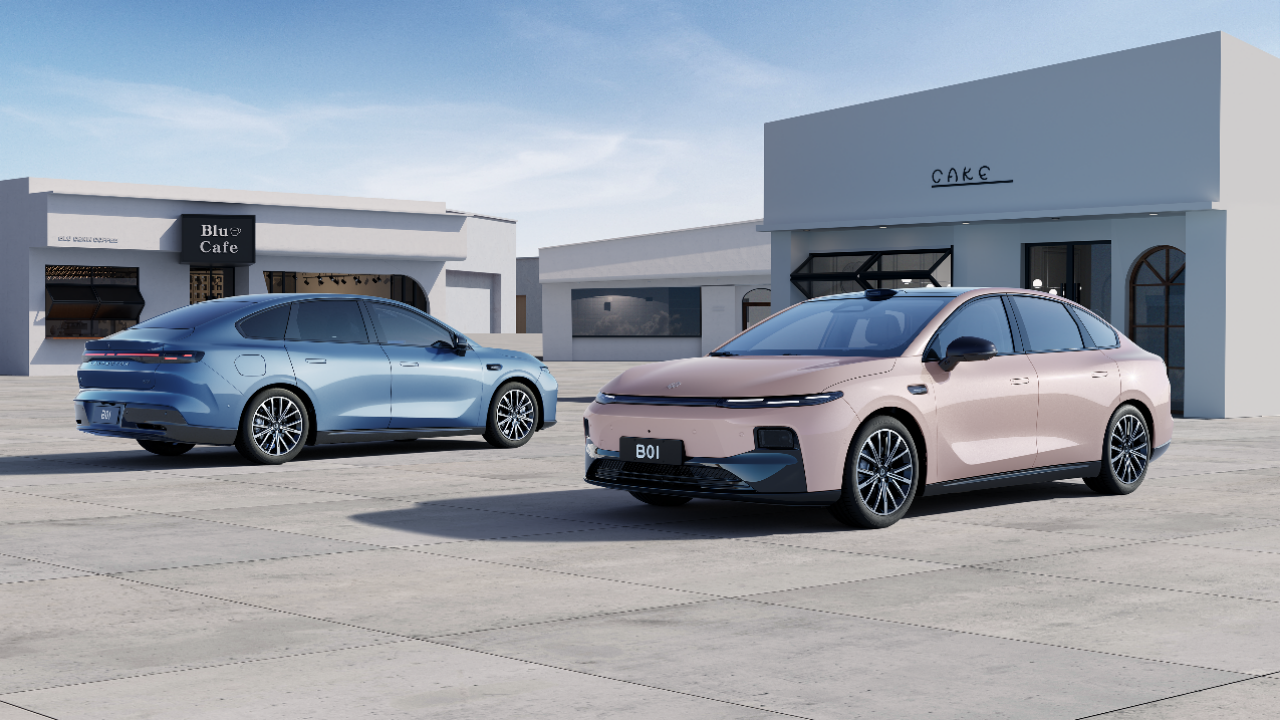The Price Release of LEAPMOTOR B01 Might Alter the Market Landscape
“LEAPMOTOR B01’s price release might change the market dynamics,” said Cao Li, Vice President of LEAPMOTOR, at the unveiling event last night before the final pricing announcement.
When the starting price of 89,800 RMB was revealed, the audience realized the statement wasn’t mere hype, as cheers erupted across the venue.
LEAPMOTOR B01 debuted in six versions: 430 Comfort Edition, 550 Comfort Edition, 550 Pleasure Edition, 550 LiDAR Edition, 650 Pleasure Edition, and 650 LiDAR Edition, with a price range of 89,800 to 119,800 RMB.
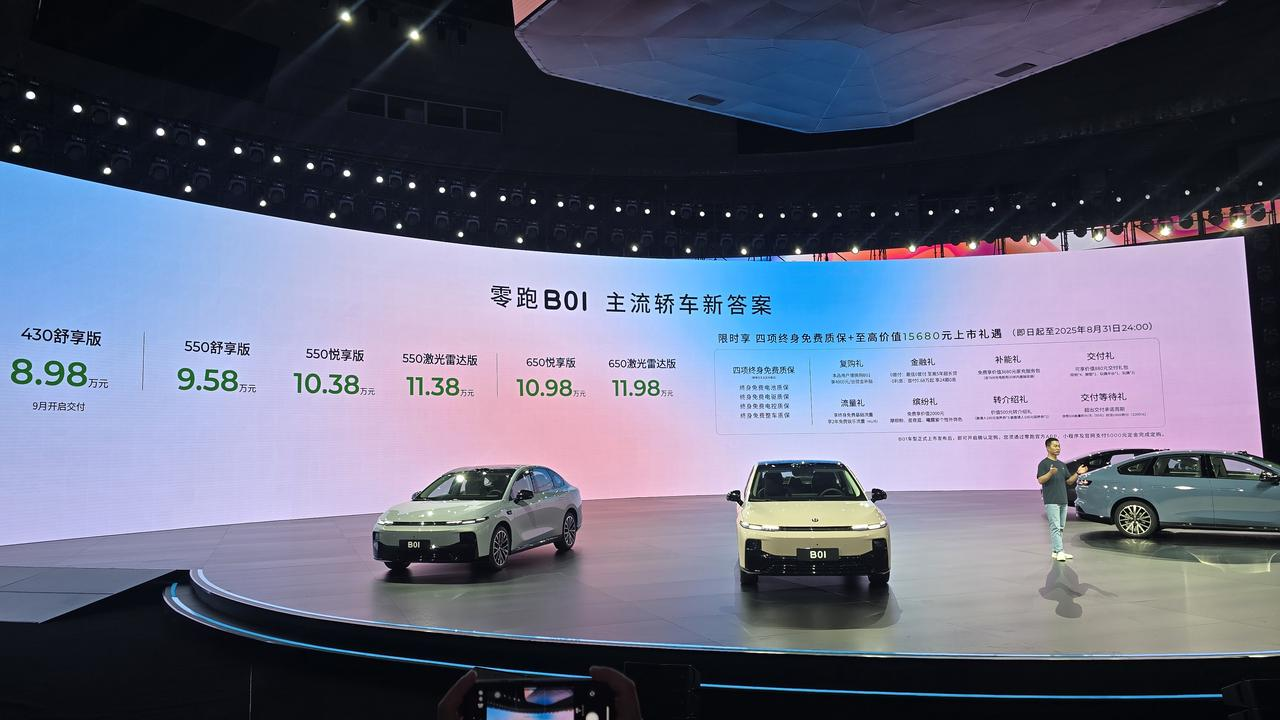
Except for the 430 Comfort Edition, which will be delivered in September, all other versions are available immediately after launch, not testing users’ patience too much.
What kind of electric vehicle can you get for 100,000 RMB? The B01 extends this question’s possibilities significantly. LEAPMOTOR offers intelligence, drivability, long range along with rare-in-its-price-range LiDAR technology, packaged at approximately 100,000 RMB with the B01.
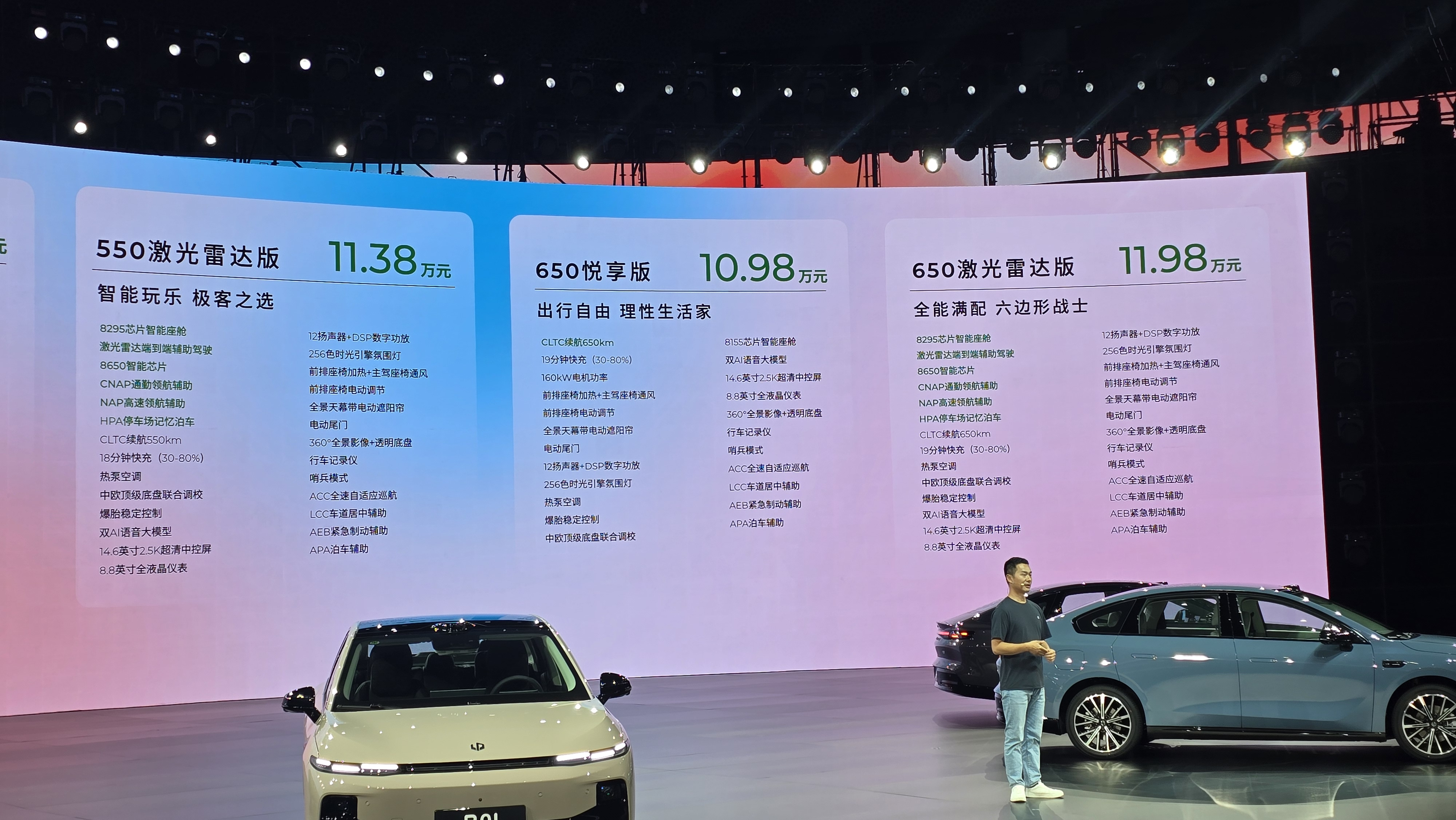
Following the unveiling event, 42 Garage participated in a media group interview with LEAPMOTOR’s Founder, Chairman, and CEO Zhu Jiangming and Vice President Cao Li. They thoroughly addressed questions like “Why is the B01 priced so low without incurring losses?”, “What driving assistance experience does LiDAR provide?”, and “How will LEAPMOTOR tackle the intensifying competition in the market?”
Additionally, they disclosed LEAPMOTOR’s major product plans for the next phase and offered judgments on the choices between range extension, pure electric, and high-end routes.
During the interview, Zhu Jiangming mentioned the B01 being dubbed the “Half-Price Model 3,” asserting, “We can match it against various metrics, and I think it indeed holds such potential.”
Design Moves from Domestic Use to Personal Delight
LEAPMOTOR B01 is the first pure electric sedan in the LEAPMOTOR B series. Its design language, intelligent features, and product strategy are more aligned with young consumers’ preferences.
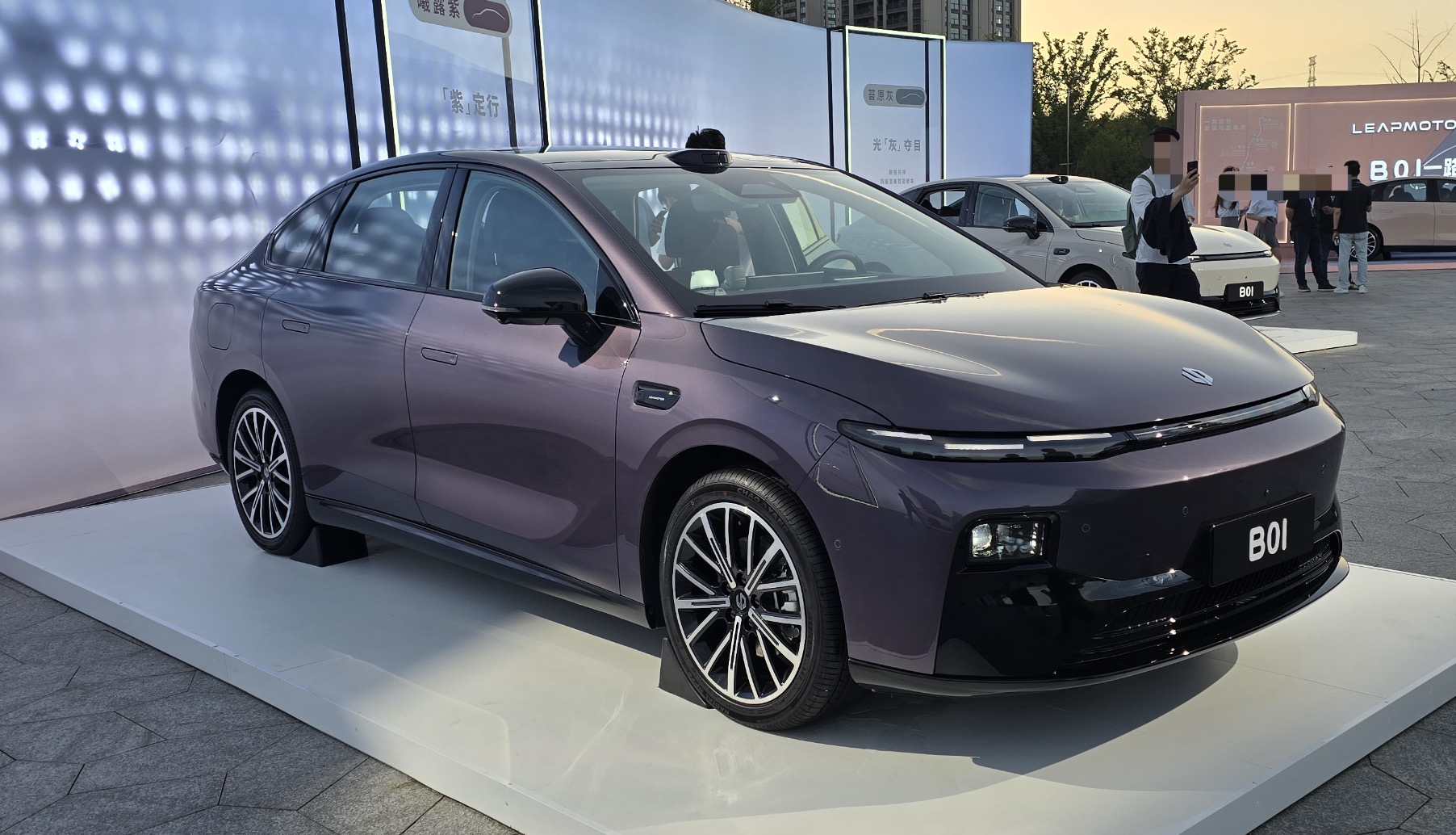
The vehicle’s dimensions are 4,770 × 1,880 × 1,490 mm, with a wheelbase of 2,735 mm. LEAPMOTOR has kept the car’s center of gravity notably low, matched with a fastback angle of 17.2° and hidden door handles, achieving a drag coefficient of 0.197.
To help the live audience appreciate this drag coefficient’s level, LEAPMOTOR’s Vice President, Cao Li, stated at the launch, “This means the B01’s drag coefficient is even lower than Tesla Model S.”Without looking at the parameters, focusing solely on the vehicle’s posture and side lines, one will notice that LEAPMOTOR, typically known for its family car image, has made a transition from functionality to aesthetic appeal with this model.
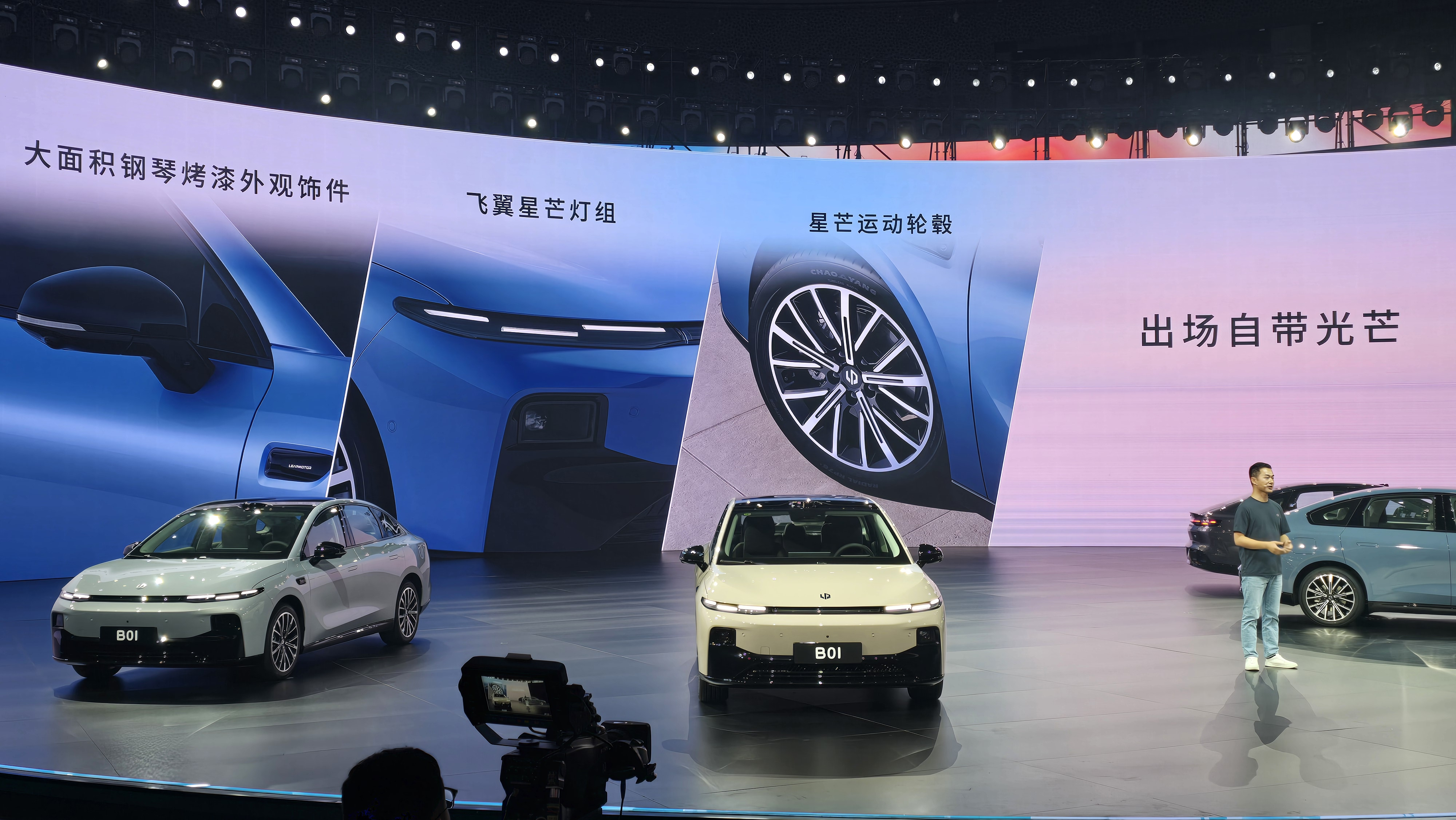
The wing starry light cluster is a highlight of the front, with a sleek, narrow outline, and the three-point daytime running lights concealed within the strip, creating a distinctive nighttime presence. In terms of color, the exterior offers 8 options, ranging from Morgan Pink and Starry Night Blue to Lavender Purple, appealing to a younger, more individualistic audience. The Morgan Pink is a custom color created in collaboration with Pantone, emphasizing a “mineral texture” with a warmer visual tone.
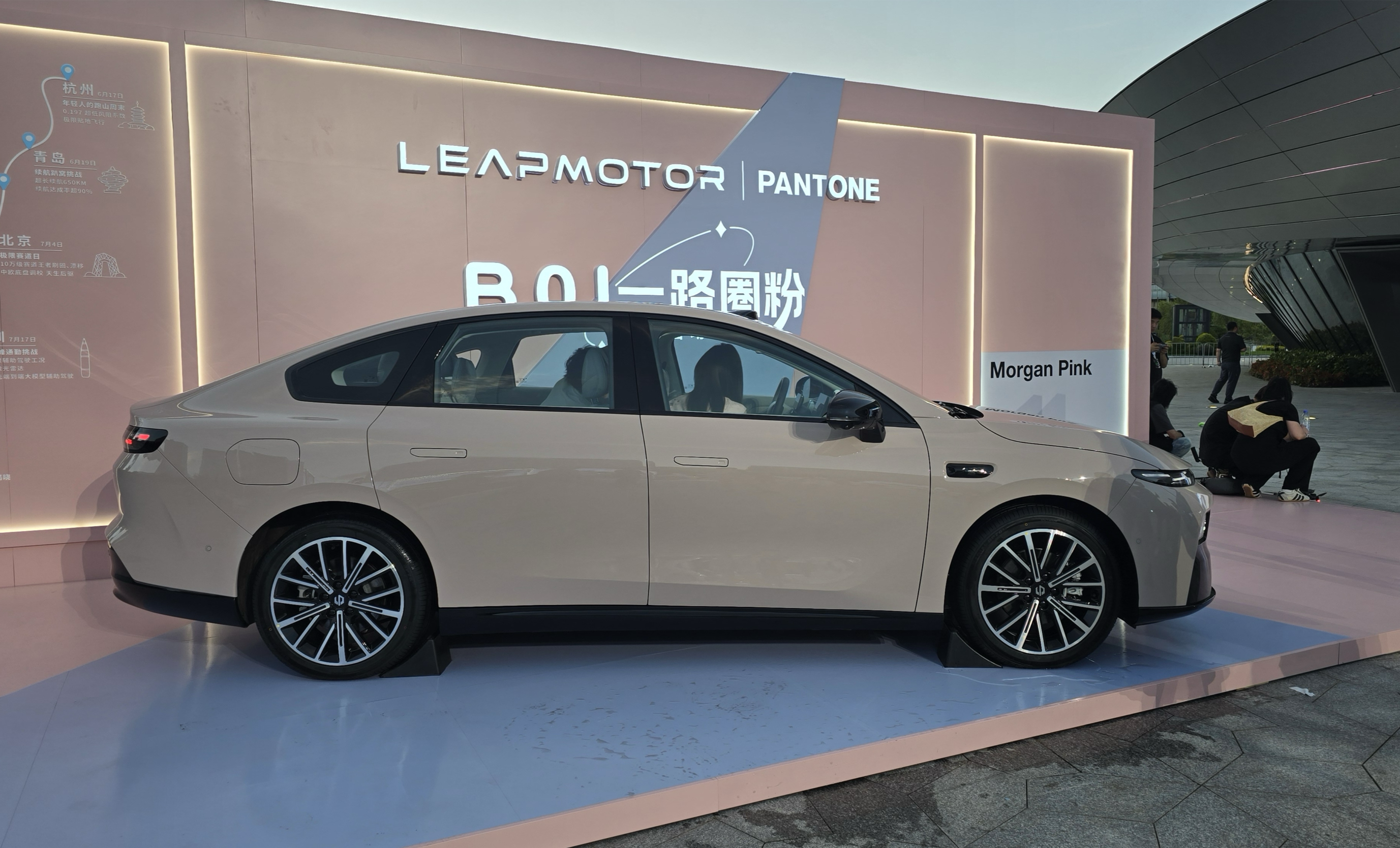
Upon opening the door, the B01’s interior design contrasts with the LEAPMOTOR C series, offering a fresher look while maintaining practicality. The 14.6-inch central touchscreen serves as the interaction hub, with driver information positioned atop the main screen, and overall operation similar to models like XiaoMi SU7 or Xpeng MONA M03.
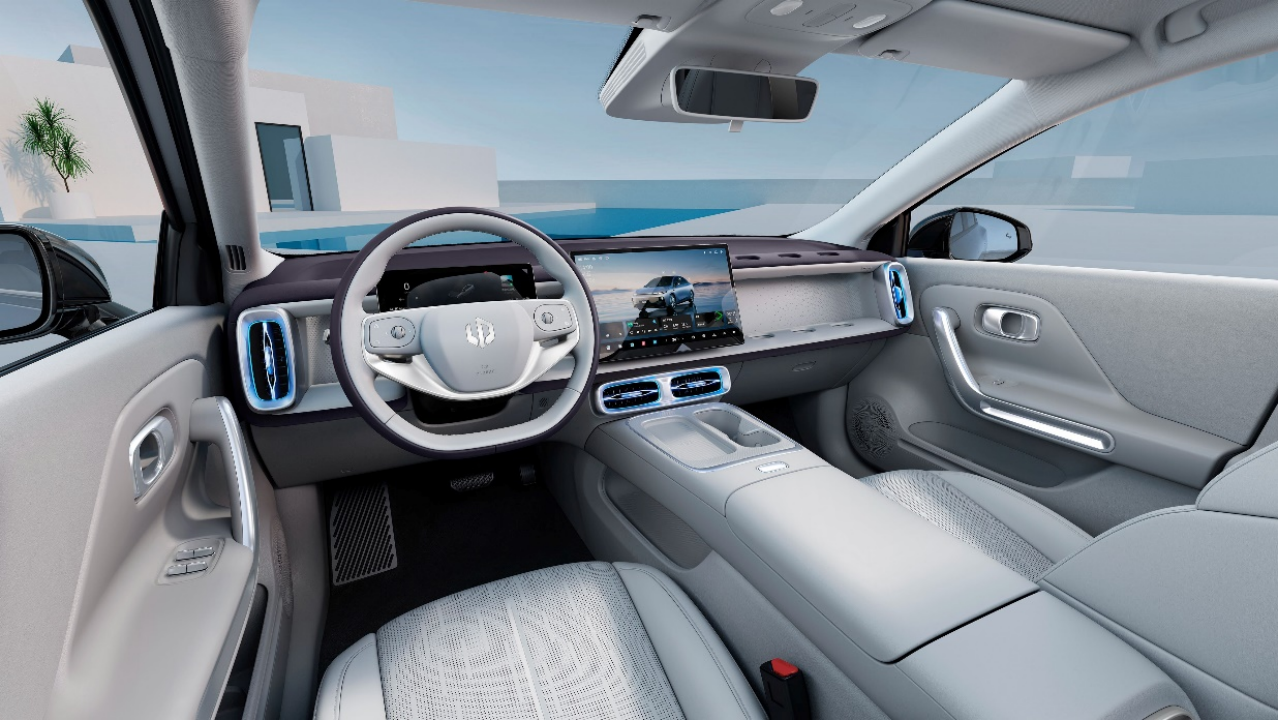
In terms of materials, considerable effort has been put into the tactile experience of the vehicle. With an 88% soft package coverage in the cabin, the focus is on the “cloud velvet leather” texture, while seats feature bamboo charcoal fiber materials, achieving OEKO-TEX baby-grade eco-certification. During our on-site experience, we noted the cabin lacked any odors and had no perceptible plastic feel.
Regarding seating, the 550 Pleasure Edition, 550 Lidar Edition, 650 Pleasure Edition, and 650 Lidar Edition all feature power-adjustable front seats, front seat heating, and driver seat ventilation. The rear seats don’t support electric angle adjustment, and the cushions are relatively short; however, thanks to the integrated battery chassis (CTC 2.0 Plus) and folded-motor layout, the B01 boasts an 86% interior space utilization, offering more rear legroom than anticipated.
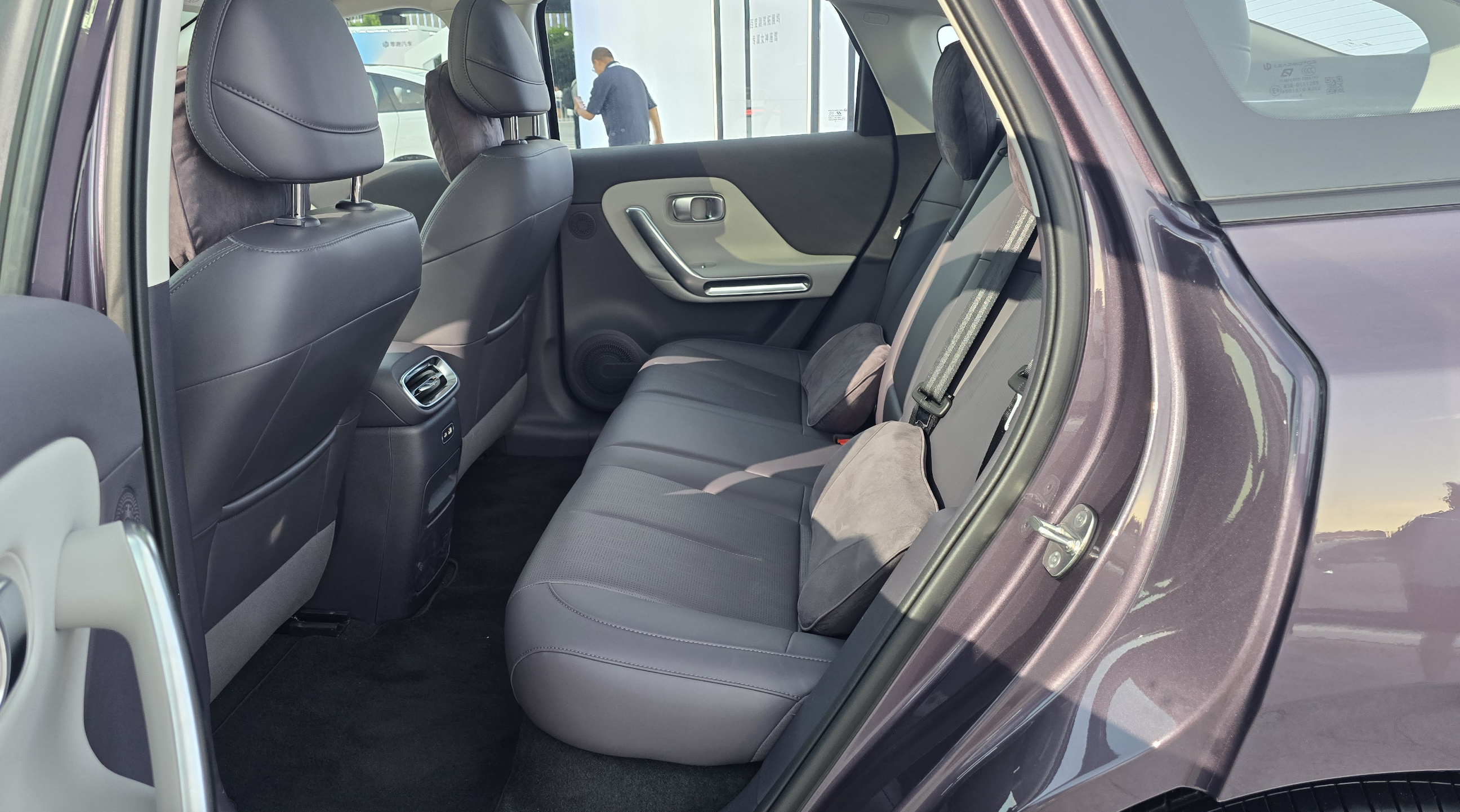
The B01’s trunk capacity is 460 liters, with a 70-liter under-floor storage compartment capable of fitting four 24-inch suitcases. Across the vehicle, there are a total of 26 storage spaces, reflecting attention to detail.
LEAPMOTOR B01 has also invested significantly in sun protection, featuring a panoramic sunroof equipped with an electric sunshade which, combined with the windshield, blocks UV rays comprehensively. The official statement asserts that both can block 99.9% of UV radiation.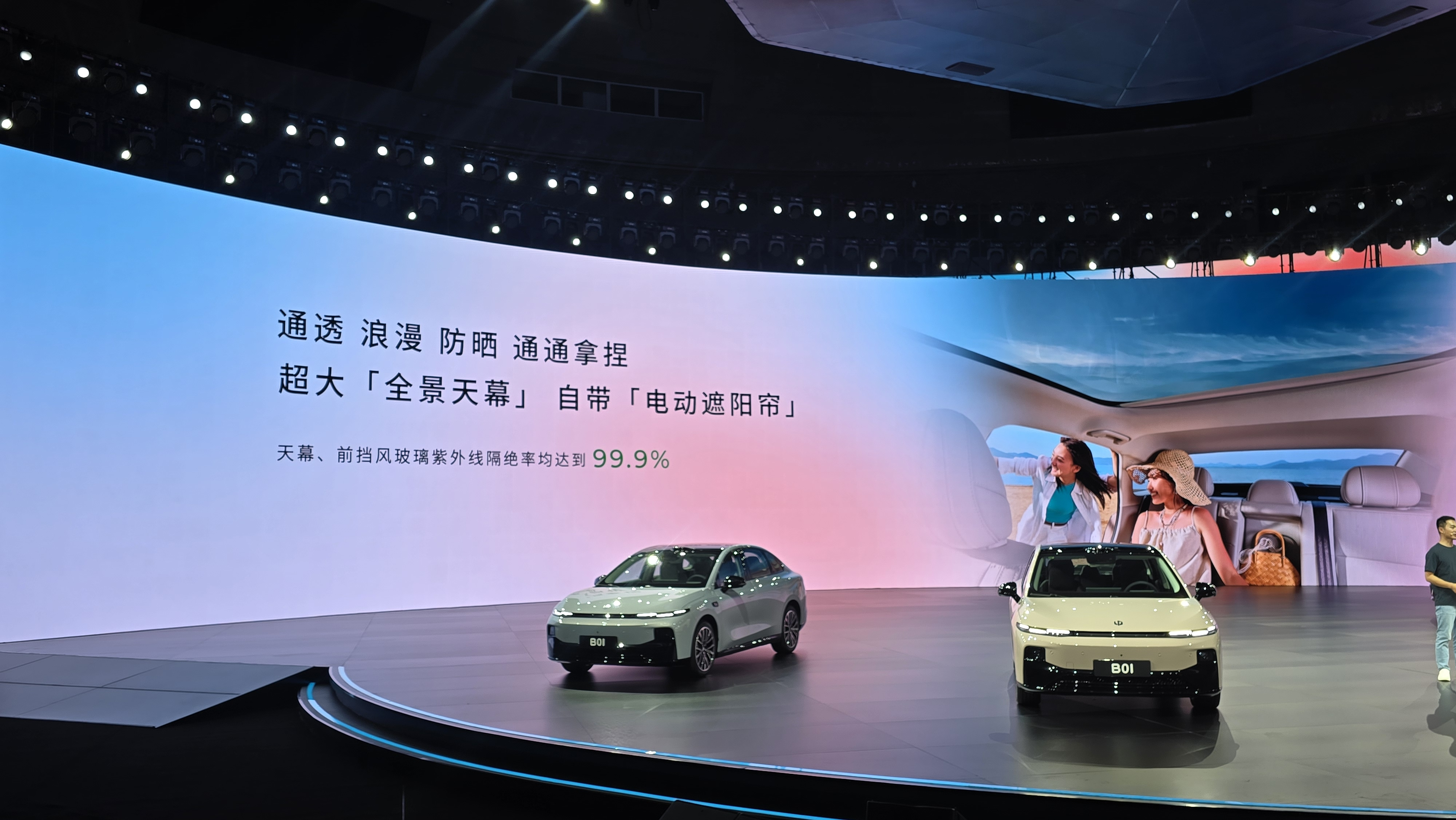
For those looking to make their first car a complete package right off the bat, the 550 Enjoyable Edition and above are well-equipped, while the 650 LiDAR version boasts superior intelligence and range that stand out against similarly priced models.
Performance without Compromise, Safety without Fear
The LEAPMOTOR B01 nails the basic expectations of young users for style and aesthetics, while striving to deliver optimal driving pleasure within a limited budget, without skimping on safety.
The entire B01 lineup features a rear-wheel drive layout, which is rare among entry-level pure electric sedans. It is equipped with a 7-in-1 high-performance oil-cooled electric drive, delivering a maximum power of 160 kW and peak torque of 240 N·m, with a quick 0-100 km/h acceleration in just 6.4 seconds.
The vehicle’s chassis design incorporates a front MacPherson and rear multi-link independent suspension, which according to official statements balances vibration absorption during low-speed city commutes with stability during high-speed lane changes. However, the actual experience is best judged through a test drive.
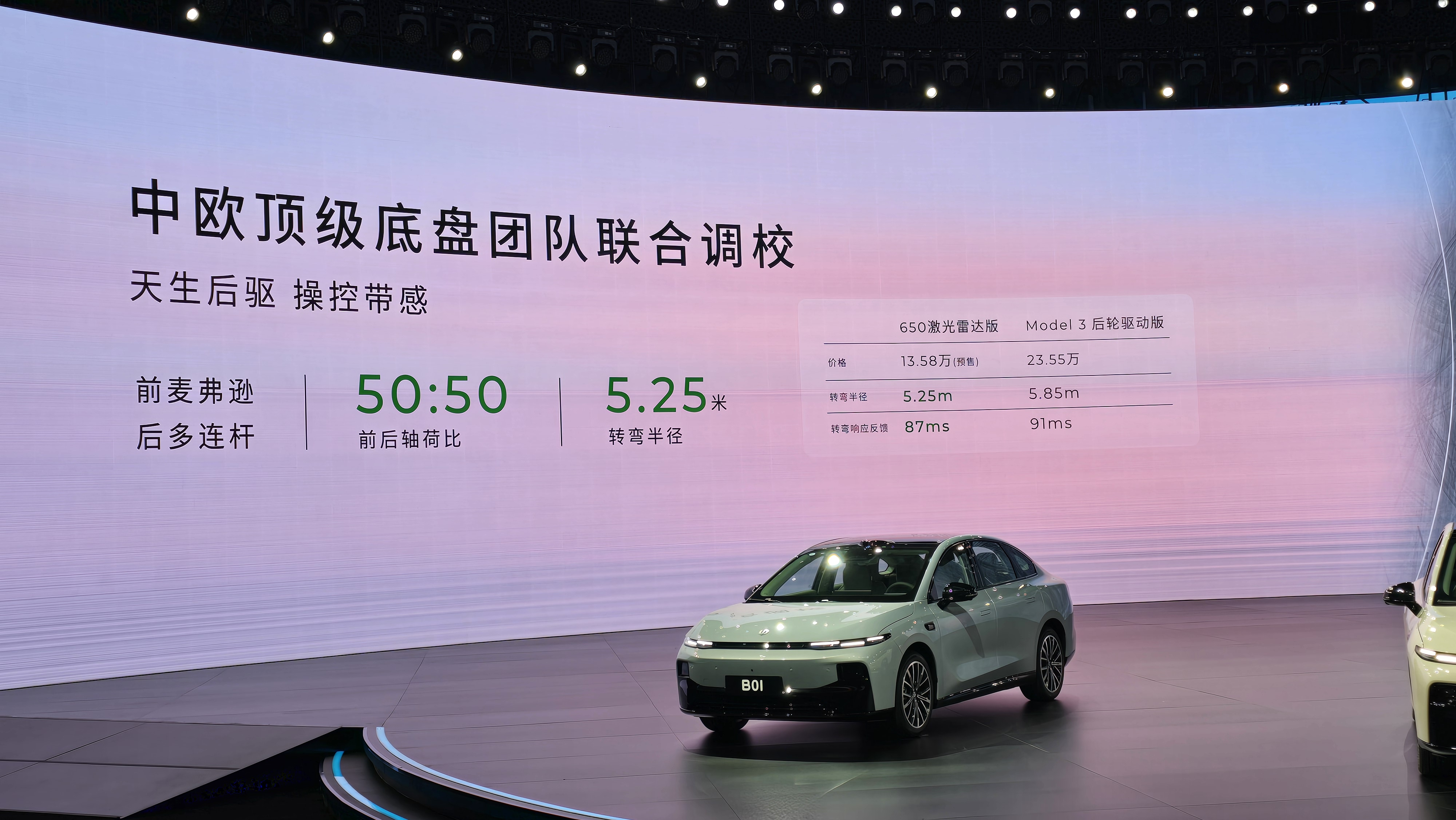
With a 50:50 weight distribution and a turning radius of 5.25 meters, agility is impressive. This turning capability offers noticeable differences in experience during narrow urban roads and U-turns.
The entire LEAPMOTOR B01 series features the proprietary LMC integrated sports fusion control technology, designed to maintain vehicle stability in extreme conditions like tire blowouts, wet roads, and high-speed obstacle avoidance. Its blowout stabilization technology can adjust vehicle posture within 500 milliseconds at speeds of 120 km/h, far exceeding human driver reaction speeds. This demonstrates LEAPMOTOR’s prowess in electronic control system integration, even though such scenarios are hard to replicate in real life.
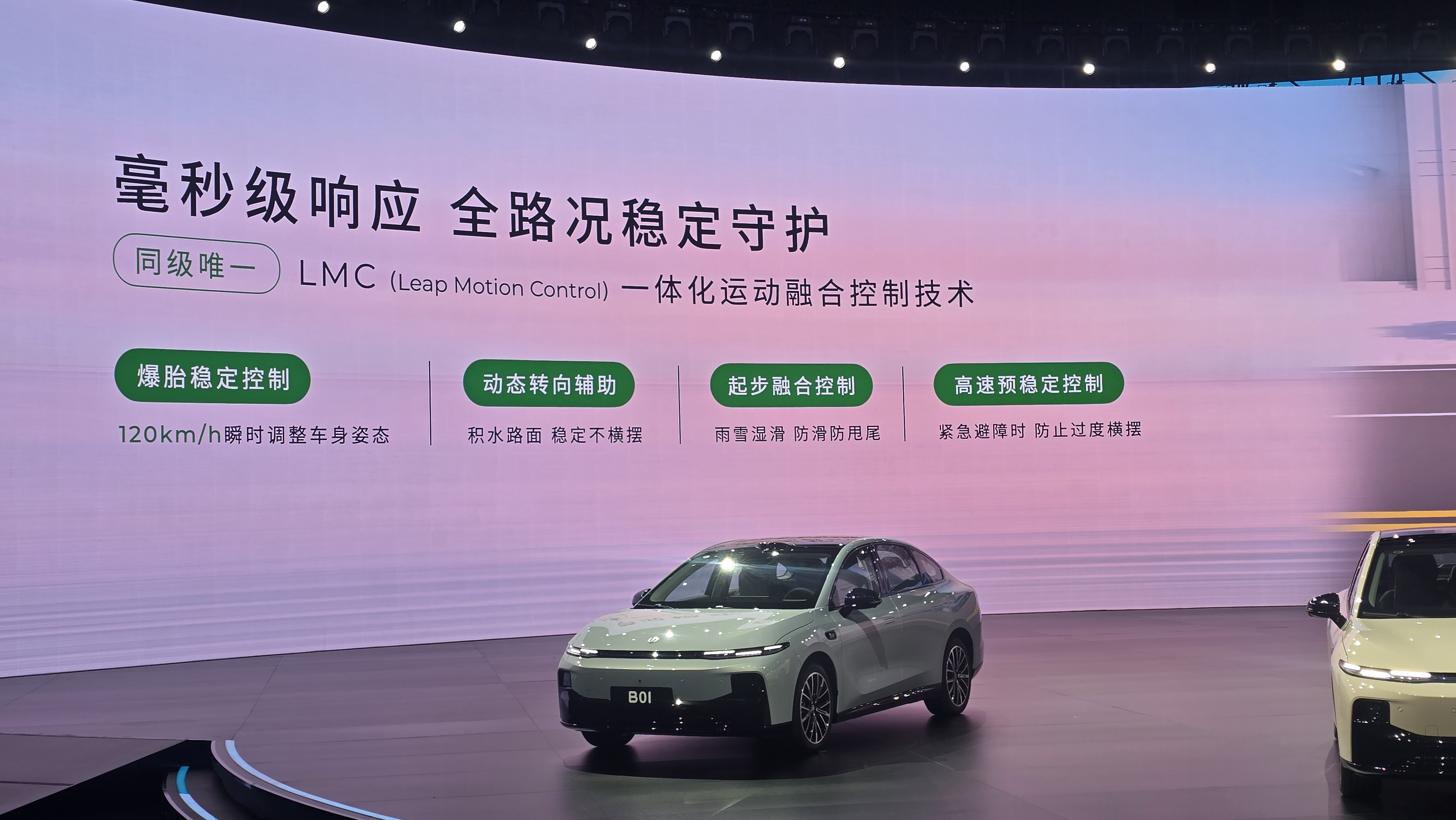
In terms of battery options, the B01 offers three capacities: 43.9 kWh, 56.2 kWh, and 67.1 kWh, corresponding to CLTC ranges of 430 km, 550 km, and 650 km, respectively. Fast charging from 30% to 80% takes about 18 minutes, with minimum energy consumption as low as 11.4 kWh/100 km. Based on current electricity rates, driving costs amount to just a few cents per kilometer.
The B01’s range capability is significantly supported by its 27-in-1 super-integrated thermal management system. This system optimizes multiple thermal management modules, reducing related components by about 60% and lowering total mass by over 15%. According to LEAPMOTOR, this system contributes approximately a 10% increase in range.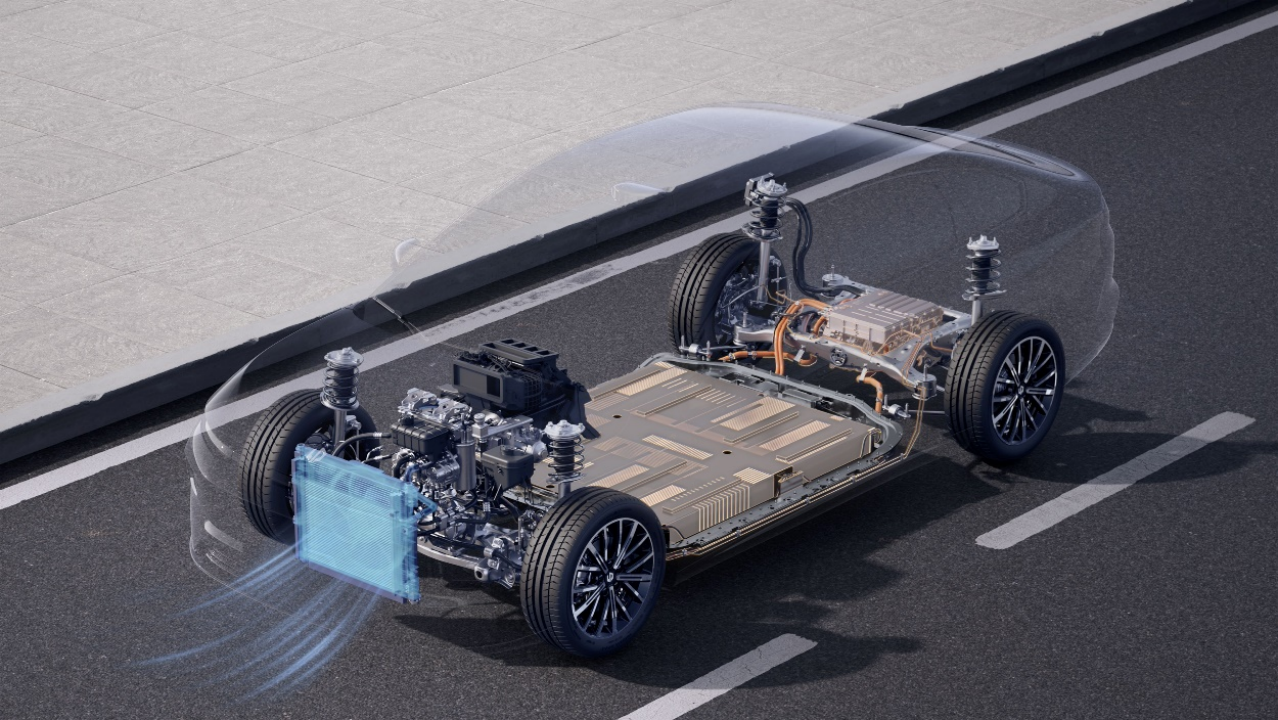
In terms of battery safety, the B01 adopts LEAPMOTOR’s self-developed CTC 2.0 Plus battery-chassis integration structure, combined with no-battery-pack and no-module technology, achieving 48 hours of zero thermal diffusion through a deeply integrated 9-in-1 battery control module. In simple terms, even if a cell malfunctions, the entire battery pack will not ignite or explode, with thermal diffusion strictly controlled within a safe range.
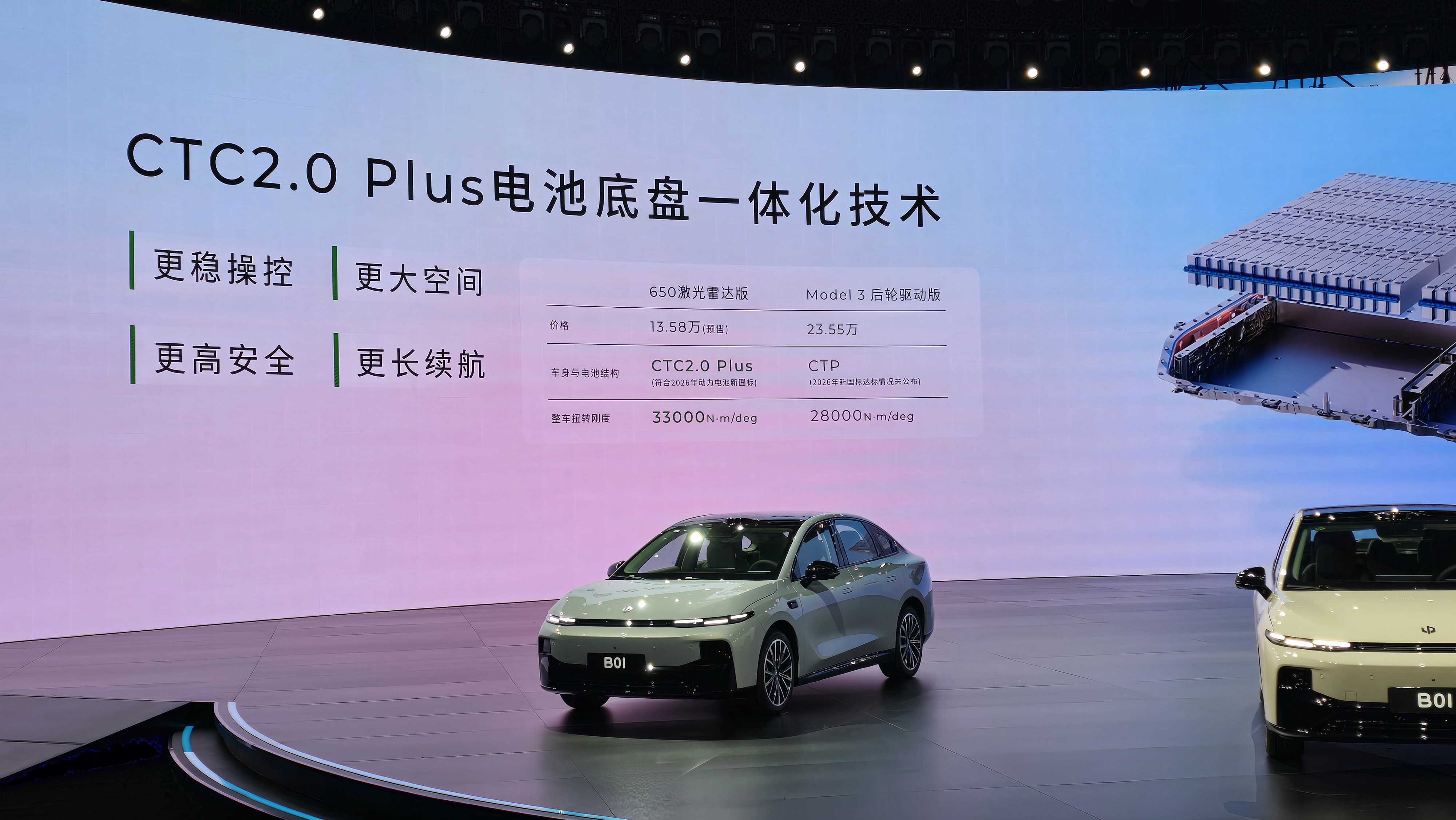
Regarding passive safety, the B01 features a “9 horizontal and 7 vertical” cage structure design with 76.6% high-strength steel, utilizing 2 GPa hot-stamped steel material in the passenger cabin area. From the perspective of material strength and structural design, the B01’s body safety aligns with the current safety standards of mainstream new energy sedans. Additionally, the B01 comes standard with a 360° panoramic image and transparent chassis, along with the standard inclusion of Sentry mode—quite rare in vehicles priced around 100,000.
Laser Radar for Cars at the 100k Level
In terms of intelligence, the LEAPMOTOR B01 does not follow the typical ten-thousand-level model’s minimal approach, instead elevating the intelligent configurations to a level unexpected for its price, offering many surprises.
The core highlights of this intelligent driving system are focused on two areas: sensing hardware and algorithm capability. In terms of the former, the B01 is equipped with 27 high-precision sensors throughout the car. For the latter, it features an end-to-end large model system, with a computing power platform reaching 200 TOPS, which is exceptionally high among its peers.
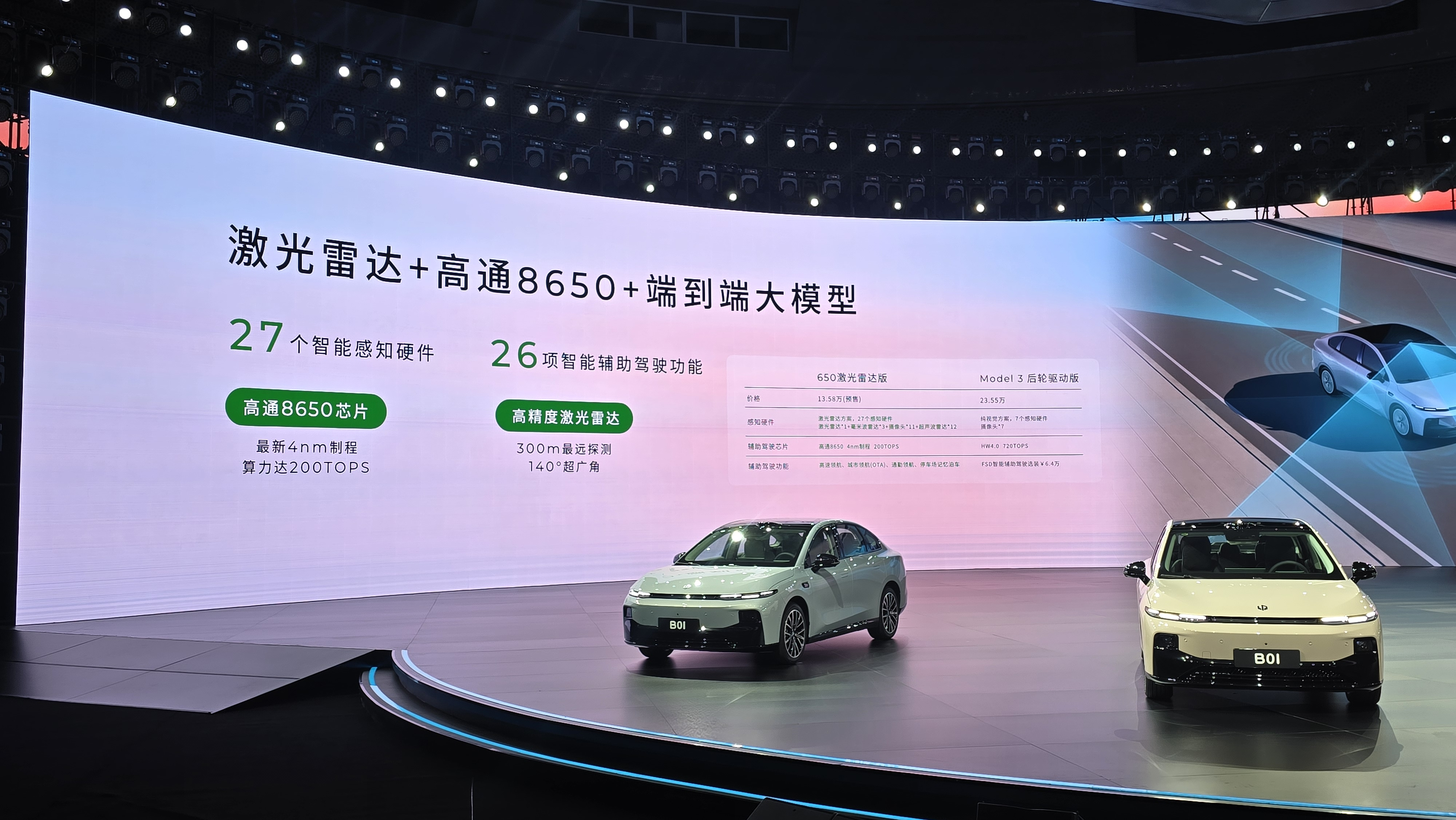
In terms of specific functions, the B01 supports 26 features, including Highway Pilot Assistance (NAP), Commuter Pilot Assistance (CNAP), memory parking, automatic parking, blind spot monitoring, forward collision warning, and active braking, covering high-frequency scenarios such as urban commuting, highway long-distance travel, and parking lots.
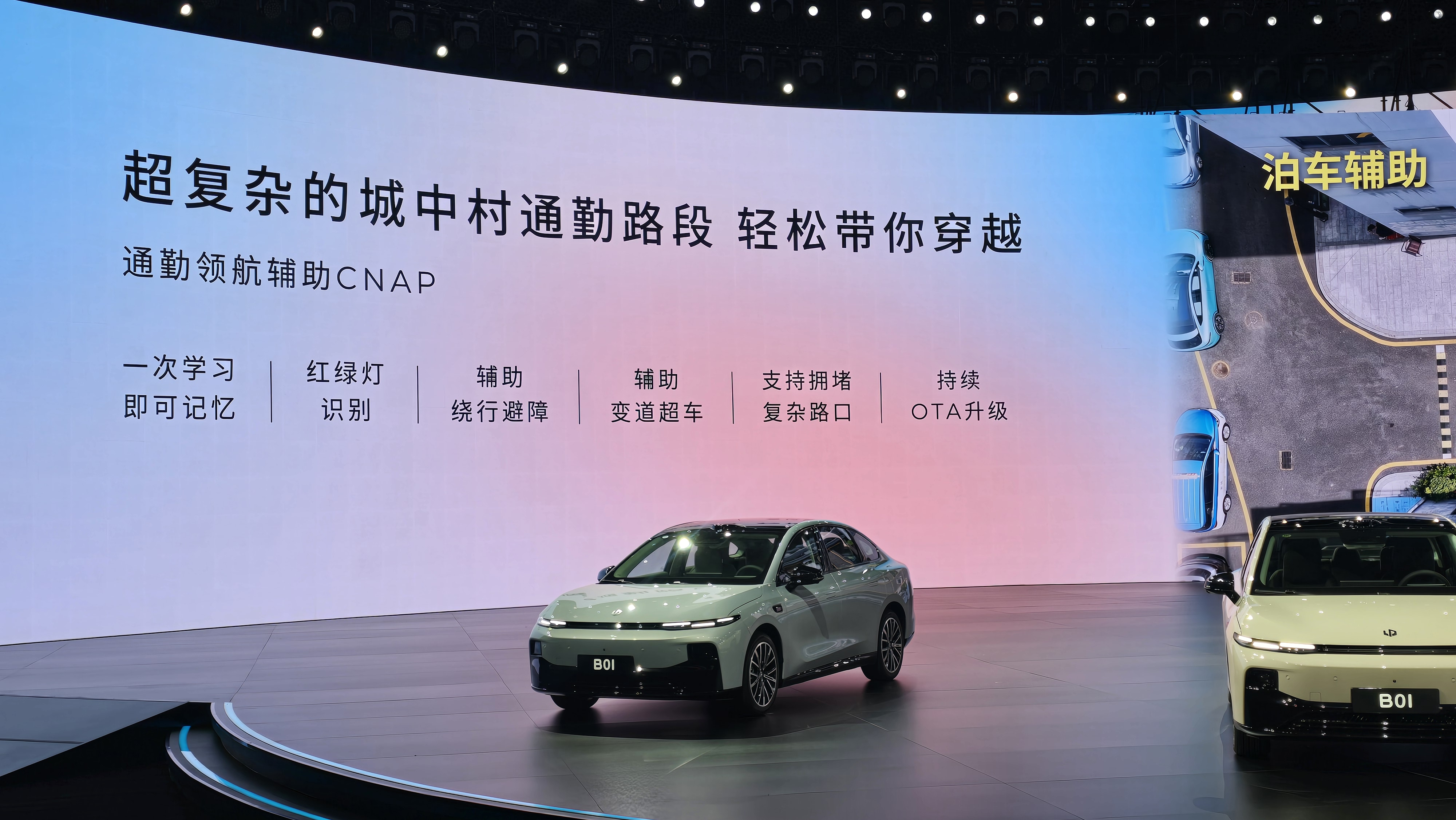
Especially in the top 650 Laser Radar version, the combination of laser radar with end-to-end algorithms allows for earlier identification of sudden scenarios, such as vehicle cutting, vehicles approaching laterally from a distance, and irregular obstacles, with the system responding faster and performing more naturally than traditional rule-based guidance.
During the launch event, Li Cao announced that the B01’s assisted driving functions are available for use upon delivery, eliminating the need for a long fulfillment period.
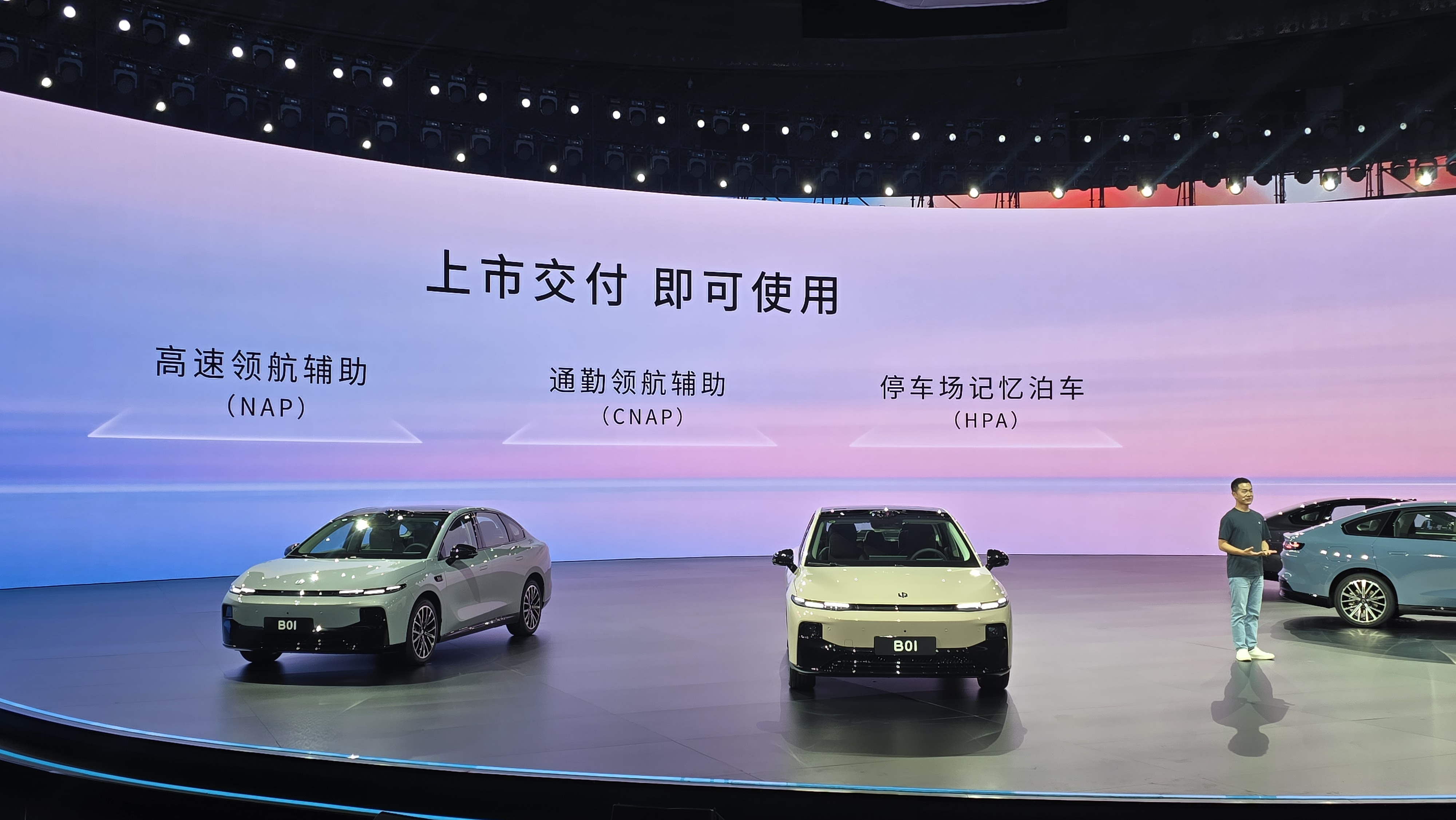
In terms of the intelligent cockpit, the B01 is equipped with the Qualcomm 8295 cockpit chip supporting a 2.5K ultra-clear display and interactions via the Leapmotor OS 4.0 Plus system. The central control interface enables multimodal recognition, 3D dynamic desktop, seamless animation effects, and zero-motion space visual interaction logic, favoring a youthful approach with responsive and fluid animations.
The B01 cockpit also integrates the “AI Super Little Zero,” with models ranging from the 430 Comfort Edition to the 650 Lidar Edition, all equipped with DeepSeek + General Inquiry dual AI voice models supporting multi-task command combinations.
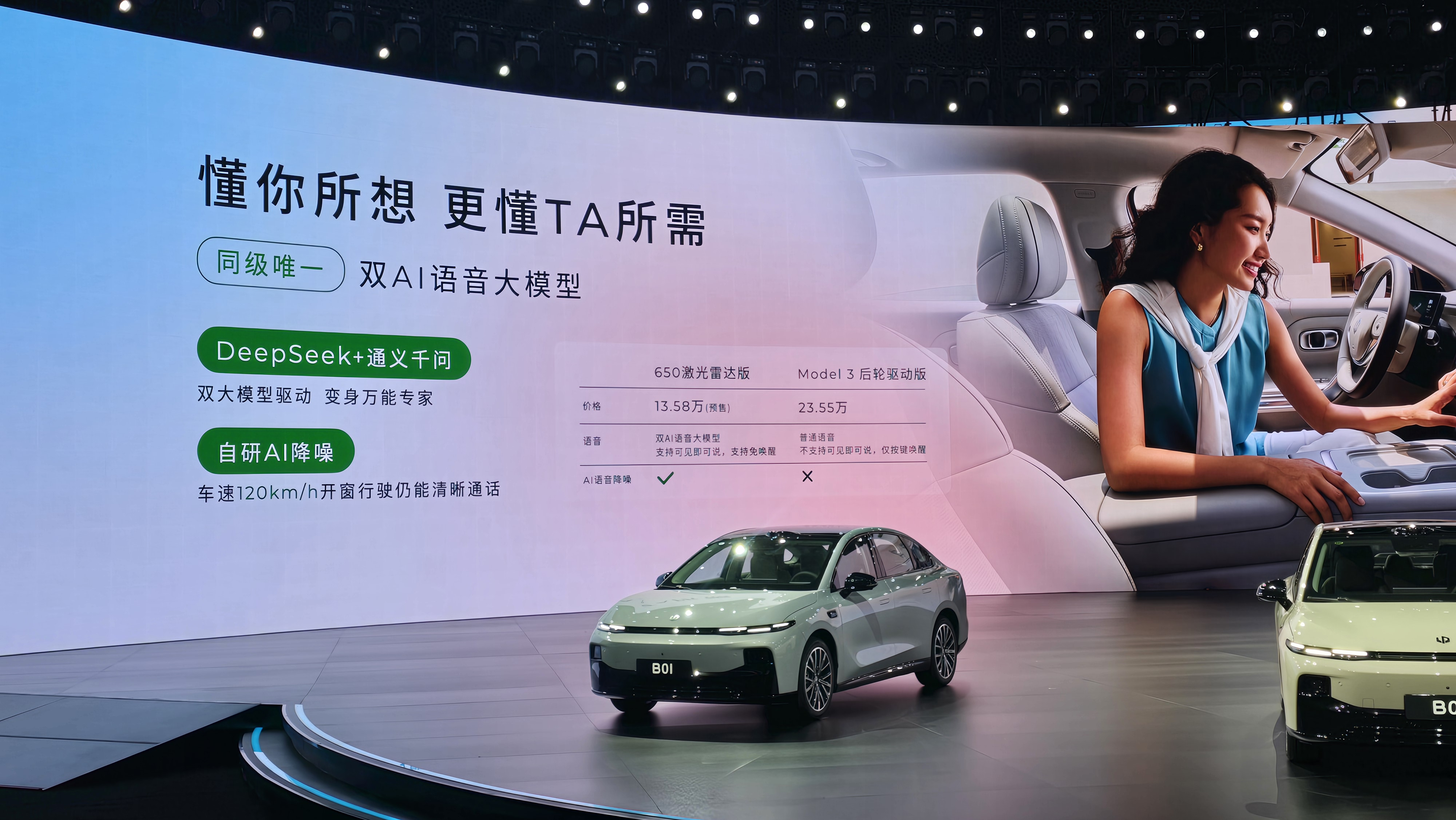
B01 to Take the Center Stage
Overall, LEAPMOTOR’s B01 does not feature particularly aggressive design or configuration, but in the ten-thousand-yuan price range, it maximizes platform capability, intelligence level, and endurance performance.
Focusing on the product, the launch event for LEAPMOTOR’s B01 was entirely narrated by Vice President Cao Li. Notably absent from the stage was LEAPMOTOR’s founder, Chairman, and CEO Zhu Jiangming. However, after the event, Zhu Jiangming and LEAPMOTOR’s Senior Vice President Cao Li gave interviews to several media outlets such as Garage 42, providing more direct responses on pricing strategy, intelligent layout, and the next phase of product tactics. The main content of the interview has been edited without changing the original meaning:
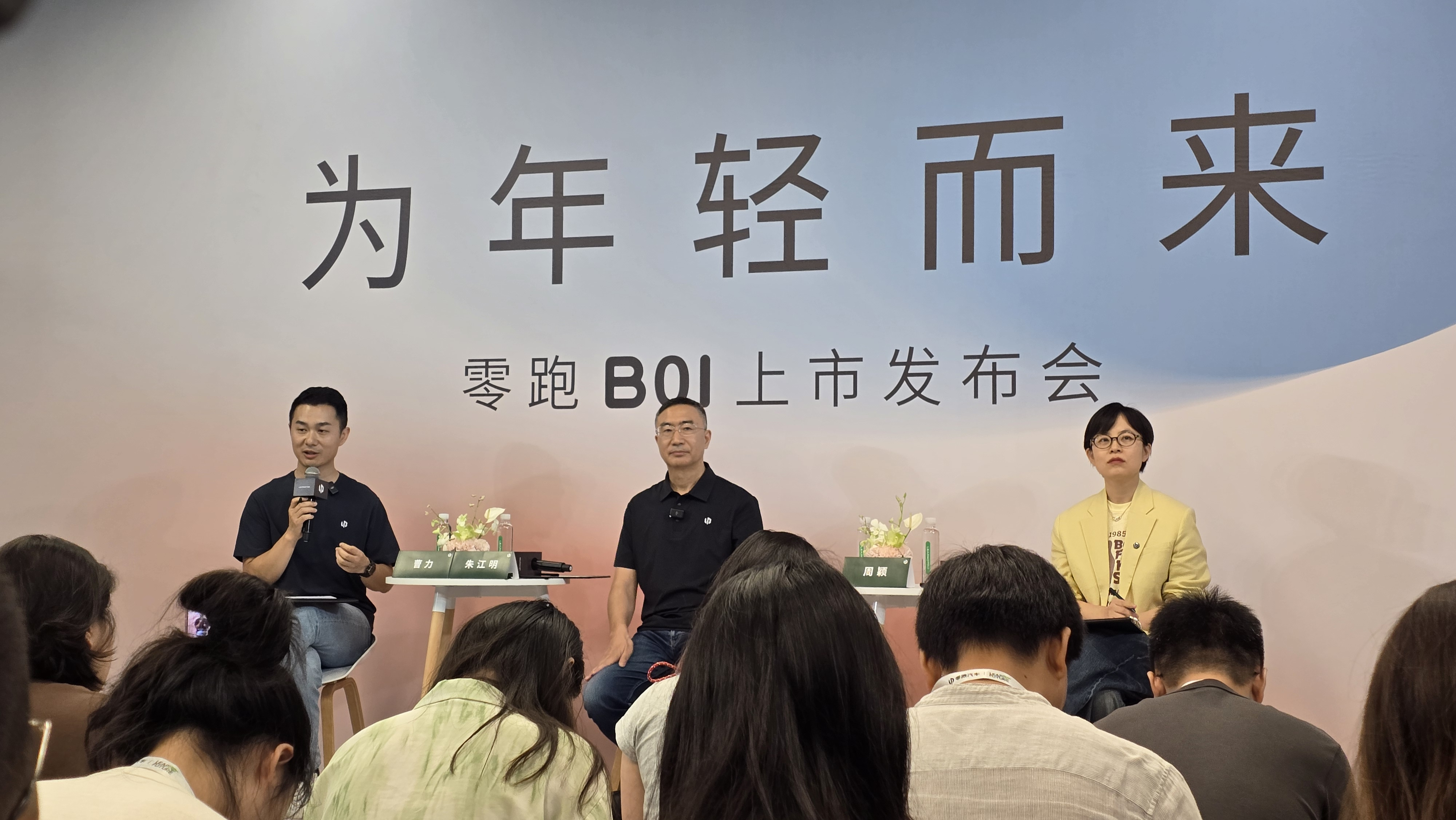
Q: What are LEAPMOTOR’s sales expectations for the B01?
Zhu Jiangming: Sales expectations, of course, are as high as possible, but LEAPMOTOR’s product characteristic is a slow-burn type. Last year’s C10 was launched in March, with initial monthly sales of 4,000 units, growing steadily to 5,000-7,000 by year’s end. Once customers used the cars, they felt LEAPMOTOR’s products were genuinely solid, with all aspects of performance exceeding their expectations, thereby fulfilling more purchases through word of mouth. Our C11 moved from an initial two to three thousand units to over ten thousand units post-midterm redesign, and C16 followed the same pattern.
Every car from LEAPMOTOR follows this same pace—a slow-burn but increasingly well-selling product. Our B10 follows this route, with monthly growth after an initial peak. We believe with B01’s strong product power, it is destined to become a highly competitive mainstay for LEAPMOTOR in the market. The B01 has been dubbed a “half-price Model 3″—they cost over 230,000 yuan and we’re around 120,000, so you can compare them as such across various metrics.Q: (Zhu Jiangming) What was your feeling listening from the audience during the launch? What are the unique selling points of the LEAPMOTOR B01?
Zhu Jiangming: Today, sitting in the audience, I felt immense pride for our product. In this launch, our intention was to showcase the capabilities of the B01 clearly, allowing Cao Li to fully elaborate on it. Our distinct selling points are endurance, driving control, intelligence, and space. LEAPMOTOR has been committed to developing models for the masses to meet essential needs, with endurance being a common challenge. Buyers of sedans expect exceptional handling; having driven this car myself for over a month, I find its handling superb, far surpassing traditional fuel vehicles. We lead in intelligence too; this time, we’ve introduced a model with LiDAR within a very accessible price range of under 120,000 RMB. The product reflects LEAPMOTOR’s sincerity, with meticulous attention to detail.
Q: How do you create cars that offer emotional value to young people? What technologies are needed for higher-tier models?
Cao Li: Our next car with significant emotional value is about to be unveiled. Keep an eye on the Munich Motor Show, where more advanced technologies will feature in higher-tier models. We expect a pivotal pre-launch of our high-end model in October, which will better showcase our emotional value and technical capabilities.
Zhu Jiangming: Emotional value is a trendy term, but it should build on fulfilling basic needs. Cars should first and foremost be pleasant to drive and functional, with comfort as a given. On this basis, we can then pursue greater emotional value; ultimately, a car remains a car.
Q: What are some technological highlights of the B01’s chassis? Are there features that exceed expectations for this price range?
Cao Li: Our current generation chassis is based on the LEAP 3.5 architecture, known for its rigidity and more balanced load distribution, which actually exceeds typical standards for this class. For instance, our vehicle stability control during a blowout at high speeds — a feature once reserved for luxury cars over $90,000 — can now be found in a car costing around $10,000. We emphasize a personalized experience through comprehensive in-house research rather than simply stacking features. While steering and braking systems are standard, all other control logic has been developed internally, and integration is seamless. Our philosophy is openness and maximizing the advantages of our in-house innovations.
Q: What are LEAPMOTOR’s goals for the next phase, especially regarding globalization and moving upscale?
Zhu Jiangming: Our current priority is achieving our target of 500,000 units in sales this year, hopefully exceeding projections. This modest goal complements a grander one: to grow into a world-class electric vehicle manufacturer, aiming for sales of 4 million units. Today marks the launch of our second new model this year, the B01, with a third new model debuting at the Munich Motor Show.In 2026, five to six new models will be launched, marking a significant year for LEAPMOTOR, with both the A-series and LEAPMOTOR’s flagship model aiming for top configurations. There might be some unexpected breakthroughs, surpassing user expectations with unique features that signify the future direction of the industry. LEAPMOTOR is not only fully self-developed, but innovation is also crucial; without innovation, there is no future. The new technological directions of LEAPMOTOR and the upcoming D-series are highly anticipated.
Q: Currently, the national standard for L2-level assisted driving is seeking public opinion, but there is controversy within the industry. Some companies hope to set high standards, while others believe that setting standards too high will increase costs, ultimately burdening consumers. There has been much debate about 60-point versus 90-point intelligent driving. What is your stance? How do you view the challenges the industry faces in intelligent driving?
Zhu Jiangming: We believe intelligent driving is still in a competitive phase, gradually approaching L3 but still predominantly human-driven. It remains an auxiliary driving tool, requiring the driver to be the primary responsible party and ready to take over. Individuals must consider safety comprehensively, including national guidance and media testing. This was well demonstrated in Dongchedi’s test; many unforeseen elements are not viable. It is merely an auxiliary driving, difficult to achieve driverless capabilities.
Cao Li: Our strategy for intelligent driving focuses on two aspects: firstly, to catch up with the leading tier and increasingly challenge the high-end sector. However, the most critical is to ensure the basic functions that users frequently use and solve daily commuting habits are practical and safe. Currently, it’s not about whose intelligent driving is more advanced, but about being more user-friendly and safer. In the high-end direction, LEAPMOTOR will also catch up swiftly.
Q: Many car manufacturers only equip LiDAR on high-end models, but our B01 is equipped with LiDAR at just 120,000. How significant is its impact on the user’s intelligent driving experience?
Cao Li: Pure vision has limitations, but with LiDAR as a supplement, safety is ensured in scenarios like foggy weather or tunnels where lighting is compromised, making many scenarios more usable and reliable, which is crucial.
Q: Are there concerns that LEAPMOTOR’s robust products might extensively enter the ride-hailing market, affecting the brand?
Zhu Jiangming: LEAPMOTOR will certainly not enter the ride-hailing market. We still aim to produce mainstream products for families, as our products are more suited for family use.
Q: Previously, many netizens referred to LEAPMOTOR as half-priced LI. Will LEAPMOTOR’s future product strategy move towards high-end? Will we develop more expensive cars, aiming at the 300,000 to 500,000 range?
Zhu Jiangming: Our D-series is the pinnacle, packed with breakthrough innovations and features, possibly a new species different from traditional pure electric or extended-range vehicles. It will include the latest technologies with top-tier suppliers globally. I can assure you that all configurations and core components of LEAPMOTOR’s D-series are sourced from the world’s top suppliers, and we have high expectations for the entire D-series.
Q: We’ve noticed that the momentum of sales for the extended-range version of the C series is not as strong as the pure electric version. How do you view the future prospects of extended-range and electric vehicles?
Zhu Jiangming: My view is that extended-range vehicles will become increasingly rare, with pure electric being the focus. Extended-range serves as a backup, like a power bank. In terms of proportion, DMI remains a relatively large common market. The market for extended-range vehicles under 150,000 is difficult because of cost structure, so it is more suitable for relatively higher-end products above 150,000.
From a larger perspective, the proportion of pure electric is bound to increase as the cost of battery cells is already low enough. We’re now at a level of 0.3 yuan per Wh for purely electric. With more comprehensive charging facilities and widespread adoption of 800 V high voltage systems, leading to faster charging, these trends indicate that the proportion of pure electric vehicles will grow.
Q: What was the pricing process for the Leapmotor B01? At what point would competitors’ price reductions make you feel pressured?
Cao Li: We have thoroughly considered the competitors’ situation. Our pricing strategy isn’t solely based on competitors’ prices but impacted by costs. Our holistic self-developed integration advantage ensures we are the most competitive in the same market segment. The government doesn’t support excessive price competition. As long as everyone maintains reasonable pricing, I believe that Leapmotor, without incurring losses, is absolutely competitively strong.
Zhu Jiangming: Leapmotor is not only striving to avoid losses, but we aim for a steady increase in gross profit margin. That is Leapmotor’s goal. Our philosophy is to deliver higher configurations and better quality than competitors at the same price point—good value without being expensive. We set prices based on cost with a certain gross margin. However, once the price is set, we won’t offer constant discounts. The price must adhere to market standards, and we hope everyone maintains uniform pricing, which is our goal.
Q: You’ve previously mentioned a target for Leapmotor to achieve explosive growth within three years. How will Leapmotor achieve this goal?
Zhu Jiangming: Firstly, reaching the goal of one million units is a must, because for any car manufacturer, if you can’t achieve it, you can’t survive. A million vehicles is a foundation for survival; otherwise, you would struggle considerably.
Q: With the current marketplace pressure and Leapmotor’s low pricing, will the 60-day payment term cause any stress?
Zhu Jiangming: Even before the government introduced policies, Leapmotor already adhered to a 60-day payment term. Leapmotor is among the manufacturers with the best reputation among suppliers. We utilize electronic automated payments that require no manual intervention once the due date is reached. As a client, it’s your obligation to pay suppliers as promised. Leapmotor’s assets are in excellent condition; to this day, we are a company operating with light assets and maintaining a very healthy financial status. Moreover, our dealerships hold nearly the lowest inventory levels.
This article is a translation by AI of a Chinese report from 42HOW. If you have any questions about it, please email bd@42how.com.
